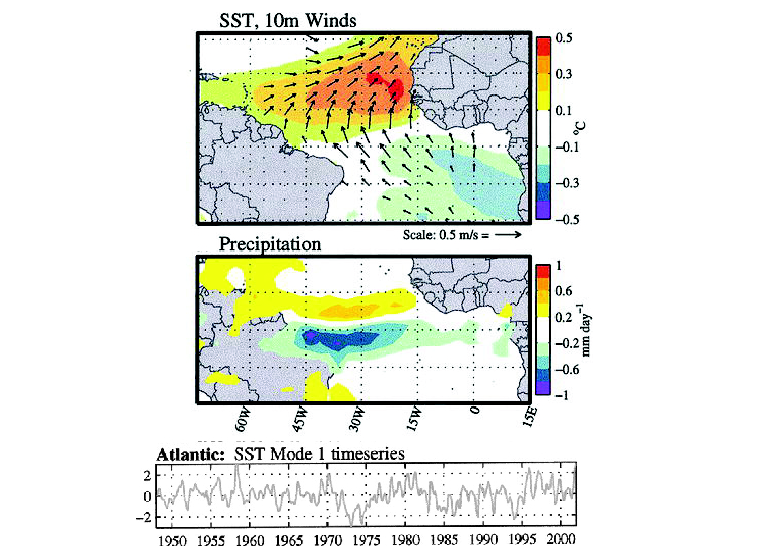Atlantic Meridional Mode
PIs: Gregory Foltz, Renellys Perez
The Atlantic Meridional Mode (AMM) is the dominant source of coupled ocean-atmosphere variability in the Atlantic. The AMM affects rainfall in Northeast Brazil and tropical cyclone development in the North Atlantic. During a positive phase of the AMM, the Atlantic Intertropical Convergence Zone (ITCZ) is displaced northward, causing drought in Northeast Brazil. Warmer than normal sea surface temperatures (SSTs) and weaker than normal vertical wind shear during positive phases of the AMM tend to enhance tropical cyclone development in the Atlantic. The conditions are opposite for the negative phase of the AMM. The AMM exhibits strong variability on interannual to decadal timescales.
A key component of the AMM is a positive feedback between the ocean and atmosphere. During a positive phase of the AMM, SSTs become warmer than normal in the tropical North Atlantic and cooler than normal in the tropical South Atlantic. Surface air pressure responds to the SST anomalies, becoming higher than normal over the anomalously cold SSTs and lower than normal over anomalously warm SSTs. Anomalous surface winds flow from the cold to the warm hemisphere, strengthening the mean southeasterly trade winds in the South Atlantic and weakening the northeasterly trade winds in the North Atlantic. The surface wind anomalies thus provide a positive feedback onto the initial SST anomalies by forcing changes in wind-induced evaporative cooling of the ocean.
Research at AOML focuses on understanding the mechanisms that drive interannual to decadal variability of the AMM and the interaction between the AMM and other modes of tropical Atlantic variability. Specific objectives are to (1) determine the role of local ocean-atmosphere coupling in observed AMM variability and (2) investigate the influence of external forcing from the equatorial Pacific and North Atlantic Ocean.

Figure 1. The Atlantic Meridional Mode, represented as the leading Maximum Covariance Analysis (MCA) mode in the tropical Atlantic. Top: Regression maps of the MCA leading mode sea surface temperature (SST) normalized expansion coefficients on SST and 10-m wind vectors. Wind vectors are plotted where the geometric sum of their correlation coefficients exceeds the 95% confidence level. Middle: Same as top, but for precipitation (mm/day). In general, shaded regions in all panels exceed the 95% confidence level. Bottom: Time series of MCA leading mode SST. From Chiang and Vimont (2004).
Publications
Rugg, A., G. R. Foltz, and R. C. Perez, 2016: Role of mixed layer dynamics in tropical North Atlantic interannual sea surface temperature variability. J. Climate, 29, 8083-8101, doi:10.1175/JCLI-D-1500867.1.
Amaya, D. J., and G. R. Foltz, 2014: Impacts of canonical and Modoki El Nino on tropical Atlantic SST. J. Geophys. Res. Oceans, 119, 777-789, doi:10.1002/2013JC009476.
Evan, A.T., G.R. Foltz, and D. Zhang, 2012: Physical response of the tropical-subtropical North Atlantic Ocean to decadal-multidecadal forcing by African dust. J. Climate, 25, 5817-5829, doi:10.1175/JCLI-D-11-00438.1.
Foltz, G.R., M.J. McPhaden, and R. Lumpkin, 2012: A strong Atlantic Meridional Mode event in 2009: The role of mixed layer dynamics. J. Climate, 25, 363-380, doi:10.1175/JCLI-D-11-00150.1.
Evan, A.T., G.R. Foltz, D. Zhang, and D.J. Vimont, 2011: Influence of African dust on tropical Atlantic coupled variability. Nature Geoscience, 4, 762-765, doi:10.1038/NGEO1276
Foltz, G.R., and M.J. McPhaden, 2010: Interaction between the Atlantic meridional and Niño modes. Geophys. Res. Lett, 37, L18604, doi:10.1029/2010GL044001.